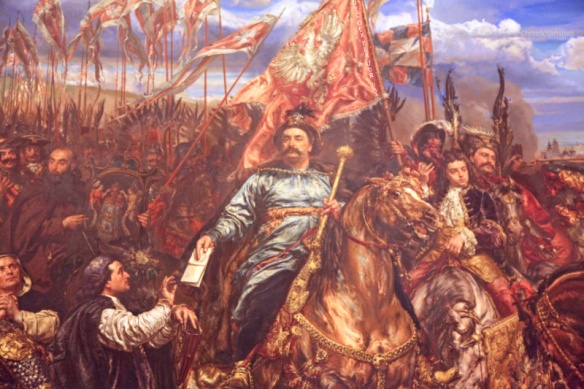Jan III Sobieski sending Message of Victory at Vienna to the Pope, details from painting by Jan Matejko in Vatican Museums.
Polish military commander, savior of Vienna. Heir to three of Poland’s wealthiest landowning families, Jan Sobieski received a cosmopolitan education and as a young man traveled western Europe on the Grand Tour. In 1648, he joined the Polish army, beginning his career with the suppression of the rebellion of Hetman Chmielnicki and his Cossacks. In protest against King John Casimir, Sobieski briefly served under Charles X of Sweden in his 1655 invasion of Poland but changed sides the following year to drive out the invader. With court patronage, Sobieski rose quickly to field hetman, then grand hetman of the Polish forces while conducting successful campaigns against the Tartars and Cossacks in the Ukraine.
In 1672, the Ottoman Empire, whose border was only 40 miles from Crakow, invaded Polish territory and Sobieski took the field against the invaders, annihilating an entire Ottoman army at the Battle of Chocim, on the Dnieper River, in 1673, only days after the death of King Michael Piast.
This victory, and Sobieski’s reputation, won him the elective monarchy of Poland. Still at war with the Ottomans, he defended the fortresses of Lwow and Trembowla and reached a truce with the sultan in September 1676. This truce gave him breathing space to improve the army, increase the mobility of artillery, enlarge the dragoons, and reduce reliance on pikemen. However, still operating within the semifeudal politics of Poland, he was unable to centralize fiscal planning or logistical supply.
Sobieski’s planned pro-French foreign policy crumbled against the realities of Poland’s relationship with the Habsburg emperor and their mutual enmity to the Ottomans; and he willingly answered the appeal of Leopold II for troops to relieve Vienna from Ottoman siege. Acting as commander in chief of a 75,000-man relief force of Lithuanians, Poles, and Germans, Sobieski, particularly skillful in his transport of artillery into the Vienna Woods and the construction of a pontoon bridge across the Danube, defeated Kara Mustafa at Khalenberg and saved Vienna. Unfortunately, attempts to follow this victory with repeated campaigns in Moldavia between 1687 and 1691 failed and drained Polish resources. Suffering repeated heart attacks after 1691 and forced to deal with the rising power of Prussia and the increasing intransigence of Lithuania, Sobieski died in 1696.
References and further reading: Davies,Norman. God’s Playground: A History of Poland. New York: Columbia University Press, 1982. ———. Sobieski’s Legacy. London: Orbis, 1985. Morton, J. B. Sobieski, King of Poland. London: Eyre & Spottiswoode, 1932.
